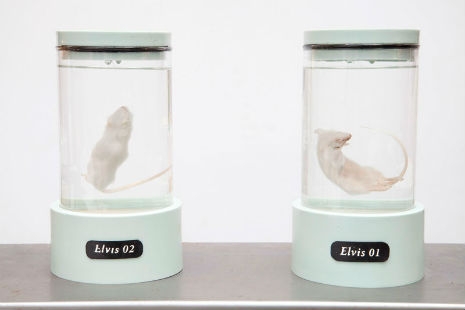
“It’s one for the money, two for the show, three to get ready now clone, cat, clone, but don’t you step on my Elvis Mouse… Oh you can do anything but stay offa my Elvis Mouse… “
Koby Barhad explains in the artist statement from his “All That I Am” installation at Design Interactions 2012 graduate show:
From a speck of hair to a mouse model.
A combination of three online services can make this project possible.
Hair samples of Elvis Presley, bought on eBay were sent to a gene sequencing lab to identify different behavioural traits (varied from sociability, athletic performance to obesity and addiction). Using this information, transgenic mice clones with parallel traits were produced. The genetically cloned models of Elvis (in this case) are tested in a collection of various contemporary scientific mouse model environments, simulating some of the significant biographical circumstances of his life.Is it possible to quantify our life through a series of conditions and events? What are the aspects of life that are responsible in making us ourselves?
Does buying a pre-owned item gives one the legal right to another individual’s genetic data?
Can mouse models of ourselves help us prepare for possible futures or will it impose them on us?
Will we make different choices Re-living the same life?
Can a mouse be Elvis? What makes you believe it can be?
Further explication via We Make Money, Not Art:
In parallel to the works performed by these laboratories, Koby has been studying the scientific mouse model environments that have been used on lab mice over the past 100 years. The cages have been designed to study and manipulate psychological aspects of mice.
Koby then made his own cages. But his were intended to reconstruct some of the most influential moments in the life of Elvis. Each of these cages offers a specific environment that is designed to influence the psychology of the mouse and make it closer to Elvis’.
Some of the main themes that the designer identified as being influential in making Elvis are: his close relationship with his mother (and so the mouse is given a mouse companion), being the victim of bullying when he was a child (in this cage, the mouse is submitted to external stimuli that frightens it), the discovery of his talents, becoming a star (features a distorted mirror that makes the mouse appear bigger), the Graceland period (in every place the mouse pokes nose, it gets a positive reaction in the shape of food or toys and keeps filling the cage to the point making it anxious), the army, the death of mum, the divorce from Priscilla are events that are represented by a cage that functions as an isolation chamber. The last cage embodies the last three years of the life of Elvis, when he worked himself to death, that period is represented by a little treadmill at the top of the cages. The mouse would run, run, run and eventually fall down.
It’s unclear if the Elvis Mouse is only being fed fried banana and peanut butter sandwiches washed down with phenobarbital, when it groggily rings for its cook in the middle of the night.
Also unclear is whether or not there is a mouse equivalent to “Dr. Nick” Elvis’s legendary doctor feelgood, who prescribed the King over 10,000 doses of amphetamines, barbiturates, narcotics, tranquilizers, sleeping pills, laxatives and hormones in the final year of his life alone.

Via Nerdcore





